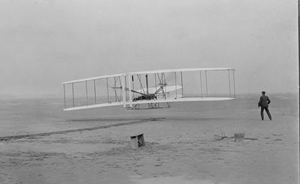talking history | syllabi | students | teachers | puzzle | about us
The Wilbur and Orville Wright Papers at the Library of Congress
http://memory.loc.gov/ammem/wrighthtml
Created and maintained by the Manuscripts and Prints and Photographs divisions of the Library of Congress, Washington, D.C.
Reviewed Dec. 14, 2005.
The Wilbur and Orville Wright Papers at the Library of Congress is an archival Web site produced as part of the fine American Memory offerings by the Library of Congress. The total presentation includes some 10,121 items and some 49,084 separate digital images from the Wright Papers or related collections held by the Manuscript Division and Prints and Photographs Division. Leonard C. Bruno, science manuscript historian and subject specialist in the Manuscript Division, oversaw the document selection process, provided subject-area expertise and guidance, and wrote historical contextual materials. Margaret Alessi Mason designed the project, developed the production plan, and coordinated the effort.

First flight, 120 feet in 12 seconds, 10:35 a.m.; Kitty Hawk, North Carolina
Users unfamiliar with the story of the Wright brothers can begin their visit to the site by browsing one or more of the introductory “Special Presentations,” which include some collection highlights, an overview of the Wright family tree, a timeline, and useful essays on photography in the collection and on the relationship of the brothers to the engineer and aviation pioneer Octave Chanute. The best entry into the main portion of the site is by means of the Browse by Series function. Users can then select any one of the basic units of the collection: “Diaries and Notebooks, 1900–1919”; “Family Papers, 1881–1944”; “General Correspondence, 1899–1952”; “Subject Files, 1889–1949”; “Scrapbooks, 1902–1914”; “Octave Chanute Papers, 1902–1910”; and the glass-plate photographs. The materials can also be accessed by keyword. Unfortunately, this function is linked to the titles of folders in the collection, not to individual items or larger topics not noted in folder names, such as “propulsion” or “aerodynamics.”
The selection of documents is very complete. It is difficult to find key items in the collection that are not available on the Web site, with the single exception of the “Wright Scrapbooks, 1914–1952”, which could not be included because of the difficulty in clearing the rights to the thousands of printed items preserved on those pages.
Individual items appear as digital images, so that the user sees a document precisely as it appears in the collection. The quality of the imagery is very high. All 303 of the glass-plate photographs through which the Wright brothers documented their lives and work can be studied in a variety of resolutions. Moreover, while the pre-1914 Wright scrapbooks were copied with multiple articles on each page, the individual items can easily be read with a magnifier.
The Web site will be of interest and value to a wide range of users. Serious students or persons with only a general interest in the subject can easily dip into any number of fascinating topics, from the technical details of the invention of the airplane to Wright family relationships to the intricacies of the patent suits that muddle the early history of aviation. After spending time exploring the site, educators will be able to craft exercises that will introduce students not only to the story of the invention of the airplane but to the process of doing history as well. All in all, this is a model archival Web site, worthy of emulation.
Tom D. Crouch
National Air and Space Museum
Smithsonian Institution
Washington, D.C.
